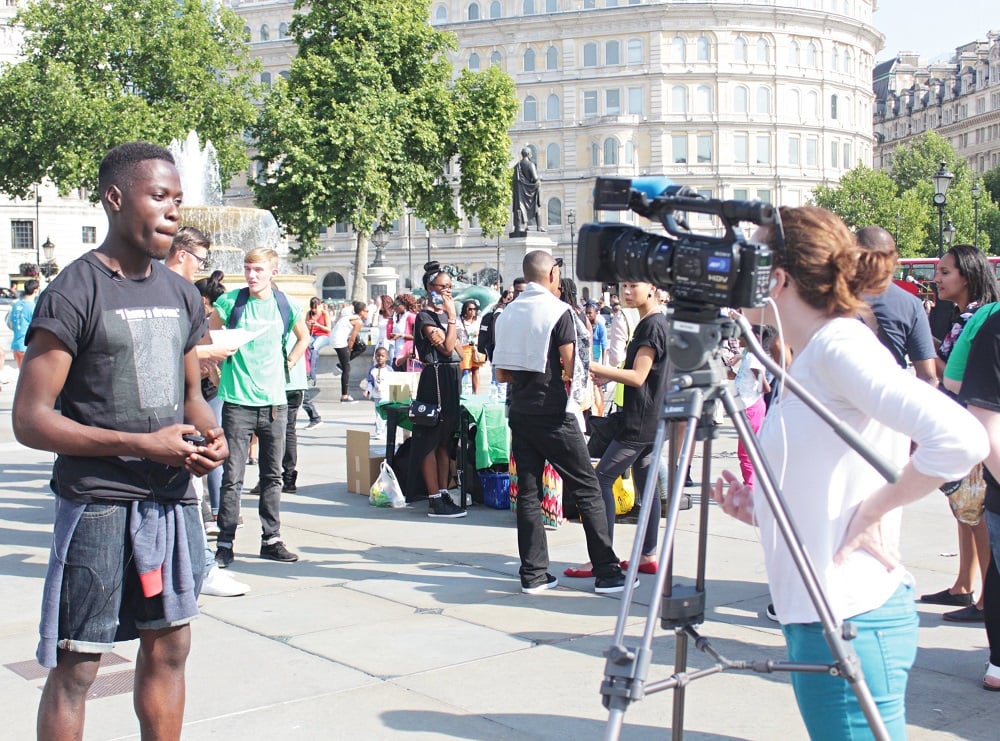
Photo: Calvin Solomon
A new way of life
Natalie Wade shares some tips on how she has been creating great art and culture for young people for whom disengagement had become a way of life.
The defined mission of Arts Council England (ACE) is “great art and culture for everyone”. However, ensuring true accessibility is a tough call, and particularly so for young people on society’s margins. Explicitly, ACE’s fifth goal is that “every child and young person has the opportunity to experience the richness of the arts”. But how do you achieve that when, for the young person in question, disengagement has become a way of life?
At Small Green Shoots we specialise in creating arts-based projects for socially excluded young people in north London and beyond. 71% of participants at our events are not in education or training, and 74% are from black and minority backgrounds. For two thirds, it will be their first involvement with the arts. This is a demographic usually bound up in the catch-all acronym NEET (not in education, employment or training), a simplistic label for more than a million individuals often living in the most complicated circumstances. The young people we work with come increasingly from pupil referral units and broken families; they often live in overcrowded rented accommodation on rundown estates.
Projects should always be relevant to the intended audience, but pandering to the obvious is a shortcut to boredom
Engaging with them is not easy. But over the past five years we have established a number of methods that have found success, resulting in work of genuine quality and talent. Here are five tips we would like to share:
- Use local knowledge: Using trusted community groups or individuals is an absolute must. Organisations we regularly work with to deliver our projects, like Focus For Life in Hackney or WISDM in Camden, know their local environment inside and out. They are credible. They have on-the-ground expertise and can connect to the kids on their doorstep. More than that, following a successful event, we find that participants tend to spread the word among their friends. Such peer-to-peer recommendation is the single most powerful route to engagement. But it has to be earned from the bottom up. We strive to encourage and nurture grassroots organisations and to help them build networks. A rising tide, as the saying goes, lifts all boats.
- Be brave: Projects should always be relevant to the intended audience, but pandering to the obvious is a shortcut to boredom. We aim to expand horizons, and in the past 12 months have developed projects around everything from Chaucer to feminism. We have enabled young people to collaborate on a branding initiative with Saatchi & Saatchi, helped forge collaborations between classical musicians and grime MCs, and filled Trafalgar Square with bellringers celebrating Martin Luther King’s iconic 'I Have A Dream' speech. Bundling a series of events under a single concept offers a particularly efficient means of delivery. For instance, our 'Dream Series' encompassed 11 standalone projects around the UK based on MLK’s speech. Our upcoming family project will see eight events delivered around International Day of Families on 15 May. Such an efficient approach ensures all partners can share resources and learnings.
- Employ credible artists and pay them: We work with a wide variety of UK talent, from respected musicians like Rodney P, Maverick Sabre, Amplify Dot, DJ Target and Trevor Watkis, through to upcoming bands and spoken word artists like Charlie Dark, Patience Agbabi and Malika Booker. Their involvement provides a double whammy: it gives the artist a unique opportunity to break new ground, while providing inspiration to the participants. Having high-calibre wordsmiths involved in a project like 'Chaucer FFWD', where young people were tasked with making personal interpretations of the Canterbury Tales, was elemental to its success.
- Act quickly and instil carrots: Once funding is secured, most of our projects are delivered within six weeks. It makes for a challenging timetable, but acting speedily ensures young participants stay focused. Our projects also build to a clearly defined conclusion, whether that is a performance, an exhibition or a qualification. Tangible outcomes are a must, and Arts Award in particular has become embedded into our work. In 2013 alone, 138 participants in our events gained an Arts Award, while we have helped five libraries become Arts Award centres.
- Use libraries: The public library system was established to benefit the poorest in our society, and those that remain open still offer amazing facilities in the heart of our communities. However, they remain underused by individuals who need them the most. As a result, we always aim to host workshops and events in library buildings, and to help libraries promote themselves as centres for the arts. The majority of first-time participants in our events will not own a library card. They don’t patronise theatres or galleries. Some barely leave their postcode. But by opening up these kind of spaces, we send out the most powerful message: that arts and culture are indeed for everyone.
Natalie Wade is Director of Small Green Shoots.
www.smallgreenshoots.co.uk
Join the Discussion
You must be logged in to post a comment.